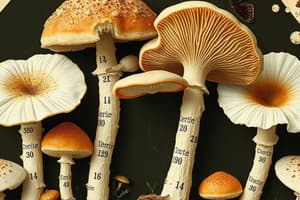Podcast
Questions and Answers
What structure in fungi consists of a mass of branching, thread-like hyphae?
What structure in fungi consists of a mass of branching, thread-like hyphae?
Which of the following is a method utilized for sterilizing fungal media?
Which of the following is a method utilized for sterilizing fungal media?
Which type of fungi are mainly involved in the fermentation process of food?
Which type of fungi are mainly involved in the fermentation process of food?
What type of microorganisms change food quality and are responsible for spoilage?
What type of microorganisms change food quality and are responsible for spoilage?
Signup and view all the answers
Which type of media is specifically used for culturing fungi such as Saccharomyces?
Which type of media is specifically used for culturing fungi such as Saccharomyces?
Signup and view all the answers
Which of the following is an extrinsic factor affecting food spoilage?
Which of the following is an extrinsic factor affecting food spoilage?
Signup and view all the answers
What is the primary purpose of pasteurization in food preservation?
What is the primary purpose of pasteurization in food preservation?
Signup and view all the answers
Which method is not a traditional microbiological examination technique?
Which method is not a traditional microbiological examination technique?
Signup and view all the answers
How does dehydration help in food preservation?
How does dehydration help in food preservation?
Signup and view all the answers
What is a primary step in preventing foodborne disease?
What is a primary step in preventing foodborne disease?
Signup and view all the answers
Study Notes
Fungi (Practical Food Microbiology)
- Fungi are eukaryotes.
- Fungi are achlorophyllous, meaning they lack chlorophyll.
- Fungi are heterotrophic, obtaining nutrients through parasitism, saprophytism, or symbiosis.
- Fungal cell walls are composed of cellulose or chitin.
- Fungi can be multicellular (e.g., Aspergillus) or unicellular (e.g., Saccharomyces).
- The fungal body is a network of microscopic filaments called hyphae.
- The mycelium is a root-like structure of branching, thread-like hyphae.
- Fungi are found in air, soil, and water.
- Fungi are commonly used in food production and can cause spoilage.
Fungal Media Preparation
- Media is a nutrient-rich material that provides food for microbes.
- Potato Dextrose Agar (PDA) and Sabouraud Dextrose Agar (SDA) are common fungal media examples.
- A liter of PDA solution comprises: 200g of potato, 20g of agar, 20g of dextrose, and 0.1g/L of Choramphenicol.
- Sterilization occurs using an autoclave at 121°C at >15 psi for 15 minutes.
- Isolation and inoculation of fungi are completed in laminar air flow.
Fungal Classification
- Kingdom: Fungi (Mycota)
- Division: Eumycotae
- Subdivisions: Mastigomycotinae, Zygomycotinae, Ascomycotinae, Basidiomycotinae, Deuteromycotinae
Types of Fungi and Spoilage
- Penicillium species can cause fruit rot (e.g., oranges) and spoil refrigerated foods (e.g., cheese).
- Aspergillus species are common in grains, nuts, oil seeds, and cured meats.
- Aspergillus species contaminate starchy foods such as bread and potatoes.
Microbial Food Analysis
- Microbial food analysis is conducted to meet certain standards, estimate shelf-life, determine food quality, and for public health purposes.
Kinds of Microorganisms (Good, Bad, and Ugly)
- Good/Helpful: some microbes naturally exist in foods or are added to ferment them for unique flavors and textures (e.g., cheese, yogurt, bread, sauerkraut, pickles).
- Bad/Spoilage: microbes change foods, causing spoilage, and affecting food quality but not necessarily food safety. Examples include discolored, mushy or fuzzy vegetables, sour milk, or slimy, putrid meat.
- Ugly/Disease-causing: microbes capable of causing illnesses ranging from mild to life-threatening. Examples include foods contaminated with Salmonella or E. coli. Symptoms include nausea, vomiting, and diarrhea.
Intrinsic and Extrinsic Factors
- Intrinsic factors: inherent characteristics of the food itself including pH, moisture content, oxidation-reduction potential, nutrient content, antimicrobial constituents and biological structures.
- Extrinsic factors: environmental factors surrounding the food (temperature, relative humidity, gases in the environment, and presence of other microorganisms).
Methods for Microbiological Examination of Food
- Traditional methods: plate counts, membrane filtration, most probable number, direct microscopic count, dye reduction tests, indicator tests
- Rapid methods: direct epifluorescent filter technique (DEFT), electrical impedance, enzyme-linked immunosorbent assay (ELISA)
Controlling Food Spoilage
- Removal of microorganisms: filtration
- Low temperature: refrigeration retarding, but not stopping microbial growth. Microorganism growth can occur below 10°C.
- Pasteurization: kills pathogens and reduces spoilage organisms. Procedures vary in heat and duration.
- Water availability: dehydration, freeze-drying (reduces free water, eliminating bacterial growth).
Prevention of Foodborne Disease
- Prevent foodborne disease through destroying or removing pathogens, preventing multiplication of pathogens, controlling time/temperature, and promoting proper food handling, employee hygiene, equipment sanitation, packaging integrity, and consumer education.
Studying That Suits You
Use AI to generate personalized quizzes and flashcards to suit your learning preferences.
Related Documents
Description
Explore the essential characteristics of fungi, including their structure, nutritional modes, and significance in food microbiology. Additionally, learn about the preparation of fungal media like Potato Dextrose Agar and Sabouraud Dextrose Agar, crucial for microbial growth studies.




